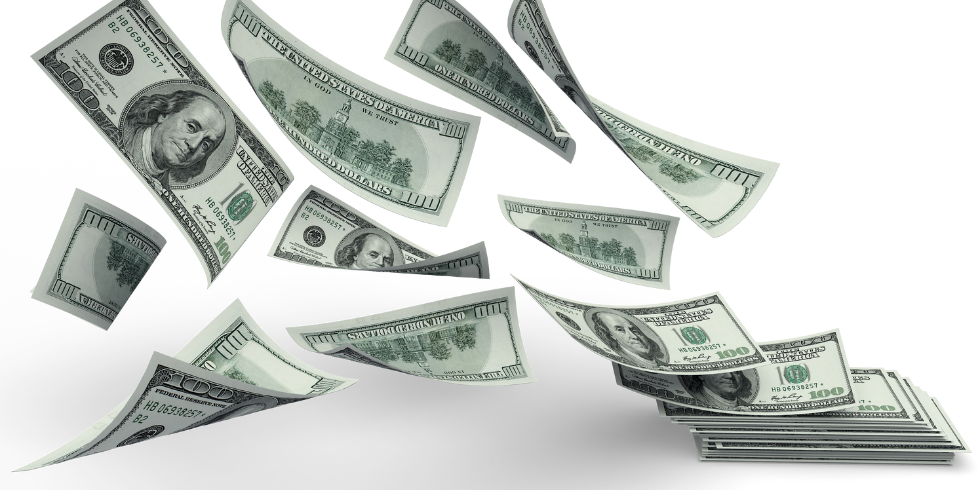When a Chief Financial Officer (CFO) speaks, many listeners conclude that a CFO thinks everything comes down to cash. Therefore, let me be clear: It is not all about the cash. However, today is my day to talk about cash flow.
(Full disclosure, I have memorized a few Bible verses to remind me that cash is not king.)
Business owners and managers who ignore cash do so at their own peril.
First: There is a reason that 50% of companies fail within five years. They run out of cash. In many cases, failure can be avoided by good strategic planning, including cash flow projections.
Second: When business owners and managers think about cash, they often find ways of increasing profits.
Third: Good thinking about cash flow can bring higher business valuations when you sell.
That makes three wins: no business failure, higher levels of profit, and a higher selling price. If you feel guilty about higher levels of profit, read that post here.
About two-thirds of businesses with employees survive at least 2 years and about half survive at least 5 years.
Bureau of Labor Statistics, Business Employment Dynamics
In my previous posts, I wrote about the ten factors to consider as you answer two strategic questions:
What should you sell?
Who is your ideal customer?
Answering these two questions is an important part of developing your growth strategy and part of your strategic planning.
The Three Cash Flow Factors
1. Increasing Cash Flow with Superior Profits
This factor is easy to explain, but requires creative thinking to implement.
If you want average profits, sell the same products and services that similar companies sell and sell them to the same types of customers. If you do things the same way that everyone else does, then you are likely to have the same profitability (net income divided by revenue) as everyone else. However, if you want superior (above average) profits, then two conditions must be true:
- You supply superior (above average) goods or services to your customers. Or you supply average goods or services to customers in a superior way.
- You target customers who appreciate and are willing to pay for superior value.

This approach requires creative thinking about what your company offers and what your customers value.
Two examples come to mind.
Apple Inc. re-invented the cell phone market. Prior to Apple, Nokia was the strong brand. Before Nokia, it was Motorola.
Apple integrated their already strong music offering into the phone. They designed one of the first fully touchscreen phones. (If they were not the first, they certainly had the best implementation of a touch screen at that time.) Apple recognized that many customers would pay a premium for that functionality and user experience.
Apple’s pretax operating income as a percentage of revenue is 27.8%. As a comparison, Sony’s operating income as a percentage of revenue is 3.8%.
Apple is a story of superior products creating superior value for customers which produces superior profitability.
I am based in Austin, Texas, the home of Yeti Coolers. If you spend time outdoors, you may have seen their rugged ice chests.
When Yeti was founded in 2006, you would struggle to find an ice chest that cost more than $100. The two founders (brothers) knew there was a market for higher quality and better performing ice chests, so they started a company to make them. Yeti’s “normal size” ice chest costs $450. You can spend $1,300 for the largest ice chest, which holds 80 gallons.

Photo: Instagram: YETI Coolers
There is no comparison between the quality and construction of an Igloo ice chest and a Yeti. There is also no comparison in the price and the profits. Yeti has a pretax operating income equal to 27.3% of revenue. That is Apple territory, which is a rare place to be for a consumer product company. Igloo’s financial statements are not available publicly, but I am confident Igloo’s profit margin is nowhere near Yeti’s.
Yeti is another story of superior products creating superior value for customers which produces superior profitability.
By the way, both Apple and Yeti also have great branding which helps them produce those profits consistently. I will discuss the topic of branding in a future blog post.
Question to Ponder: How can you produce superior products or services for your customers?
Remember it is not always what you produce, but sometimes it is how you deliver your product or service that creates superior value for your customer. Let other companies enjoy being average.
2. Cash Flow Projections: Cash Requirements and Availability

Not all products and services are created equal when it comes to the cash required to grow a company. Some products or services require significant cash investments in inventory and receivables; other products or services may not require nearly as much.
Even for specific products and services, the cash required may vary by the type of customer. For example, large companies and governments tend to pay 60 days or more after receiving an invoice. Other types of customers may pay some or all in advance. Understanding the payment times of your potential target customers may influence your decision about what type of customers to target. It should not be the only factor that you consider, but it is an important factor.
With interest rates so low, the cost of the cash usually is not an issue. The issue is the availability of cash. If your company has significant inventory and receivables and you are growing quickly, then it is quite easy to run out of cash – even if you have a bank loan collateralized by inventory and receivables. Some of the cash required can be reduced by getting long payment terms.
As you consider options for what you should sell and to whom you should sell it, be sure to model any differences in the timing of the different kinds of cash flows. The failure to do that type of strategic planning could cause you to run out of cash or force you reduce your revenue growth rate.
3. The Final Cash Flow: Exit Strategy and Timing
Some business owners sell because a buyer offers a great price. Others sell when life’s circumstances demand it. Most business owners sell at a time of their choosing. For most business owners, it is not a question of “if,” but a question of “when.”
I hope you will be ready.
What does selling a company have to do with answering the questions of what should you sell and to whom should you sell it?
First, the easy answer: If you are planning to sell in the next three to five years, you do not want to make any dramatic changes. Answering these questions can help you narrow your focus and increase your profitability in that time period. However, you do not want to make a dramatic change, because you may not be able to show the results that you need to maximize your selling price.
If your likely sale date is more than five years away, then answering these questions can have a dramatic impact on your sales price.
In the section above, I explained how answering these questions can increase your profitability. Typically, a buyer values a company at a multiple of its pre-tax cash flow. One form of pre-tax cash flow is called EBITDA, which is an abbreviation for Earnings Before Interest, Taxes, Depreciation, and Amortization. The multiple or multiplier is based on the industry, interest rates, and the balance between sellers and buyers. As a general guideline for businesses with less than $50 million in revenue, I start with a five multiple of EBITDA and move up or down based on the industry.
EXAMPLE: If a company has $5 million in EBITDA and the industry multiple is 6 times EBITDA, then the value would be $30 million. This valuation methodology produces the “enterprise value.” The value of the owner’s equity is equal to the enterprise value plus the cash balance and minus any outstanding debt (other than accounts payable). In most cases, there is no extra value for the inventory, accounts receivable, equipment, or other assets of the company because these assets are required by the enterprise to produce the EBITDA.
In this example, the enterprise value is $30 million. If the company answers these two strategic questions and increases EBITDA by $1 million, then the enterprise value increases by $6 million – a nice reward for the effort in addition to the increased profit each year prior to the sale.
There is one more factor to consider. In many cases, owners know which companies might be the potential buyers. As you answer these two strategic questions, you want to make sure that the answers are consistent with the type of business that the potential buyers would want to buy. Some buyers want to broaden their offerings of products, services, or customer types. Other buyers want to increase the market share of their current offerings and customer types, so they want to buy companies that look just like them. Some buyers buy both types of companies. The best indication of what they want to buy is what they have purchased in the past.
The domain of cash flows is one area where CFOs excel.
Have questions? Be sure to ask them in our contact form.
Summary
When you are ready to answer the strategic questions of what should you sell and to whom should you sell it, there are ten factors to consider. Below are those factors with links to the two previous posts.
The People Factors
- Investor expectations (if you do not own 100% of the business)
- Personal ambition, goals, and tolerance for risk
- Personal experiences, network, skills and abilities
- Your key employees’ experiences, networks, skills and abilities
Three Factors that Keep It Real
- The business’ current product or service offering
- Market growth in your target markets
- Competition in your target markets
The Cash Flow Factors
- Increasing cash flow with superior profits
- Cash flow projections: cash requirements and availability
- The final cash flow: exit strategy and timing
Define your product or service offering and your ideal customer for the next few years – it is not forever. Once you conquer the market for one product or service offering and one customer type, then you can add new people and expand. It is just difficult for a company to get really good at multiple product or service offerings and customer types at the same time. Such an approach demands a lot of cash as well as time and energy from the CEO. This approach frequently results in low profits. Sometimes, it is just impossible.

